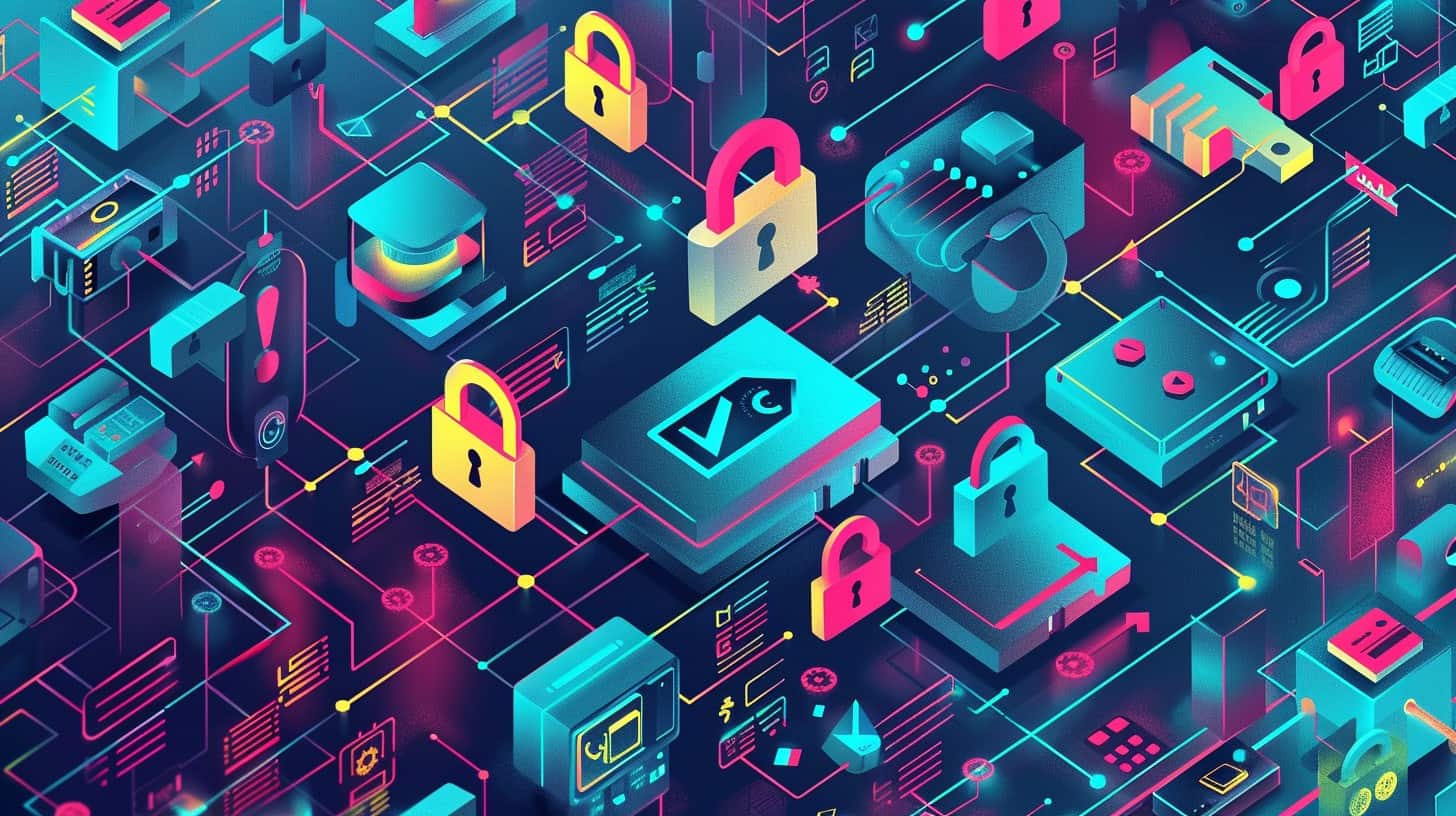Dealing with IaC can feel like unlocking a secret door, but what if the key doesn’t fit? Infrastructure as Code has changed the game by making our cloud infrastructure setup faster and more consistent.
This post will guide you through sidestepping sneaky security risks that might trip you up along the way. Ready to play safe?
Key Takeaways
Scan your IaC templates with tools like TFLint and Checkov to catch errors and vulnerabilities before they cause harm. This helps keep your cloud infrastructure secure from threats.
Use secure, well-tested templates for setting up your infrastructure. This reduces the risk of security issues from unverified code.
Set default security settings in your IaC practices to create a consistent and safe environment. It’s important for keeping everyone on the same page and preventing unauthorized access.
Choose wisely who can create and apply IaC templates. Using role – based access controls ensures only trusted team members can make changes, reducing potential risks.
Regularly check for misconfigurations, ghost resources, exposed secrets, configuration drifts, and excessive privileges to prevent security breaches. Tools like truffleHog and GitGuardian are useful for spotting hidden problems.
Table of Contents
Understanding IaC (Infrastructure as Code) Security

IaC turns the heavy lifting of setting up servers and networks into a piece of cake. Imagine telling your computer to get things done, and it does, just like magic. But with great power comes great responsibility.
Security in IaC is about making sure that this magic doesn’t turn sour. We’re dealing with codes that control big parts of the internet, folks! So, securing them is not something we can skip.
Version control steps in as our first line of defense. It keeps track of every change like a meticulous librarian. This way, if something goes wrong, we know where to look back. Then there’s the principle of least privilege – fancy talk for giving users only the access they need and nothing more.
Think about it like having keys to only certain rooms in a giant building. These steps help make sure our code stays safe and sound while doing its job efficiently – managing all those servers and databases without breaking a sweat.
Importance of IaC Security

Jumping from understanding the basics, let’s talk about why securing IaC is as crucial as locking your front door at night. Imagine a tiny mistake in your code spreading like wildfire, turning what was meant to be a fortress into a house of cards.
That’s exactly what happens when security takes a backseat in Infrastructure as Code environments. A single overlooked flaw can invite trouble across hundreds—maybe thousands—of resources deployed in the cloud.
Tools like configuration checkers shine here, playing detective before any code hits production. They sift through templates looking for anything amiss—think of it as having a cyber guard dog that barks at potential intruders.
And with open source IaC scanning solutions like KICS, getting this level of protection doesn’t have to break the bank. It’s about making sure every piece of your digital puzzle fits perfectly, keeping out those who shouldn’t wander in.
So yes, dotting your i’s and crossing your t’s with IaC security isn’t just good practice; it’s essential for peace of mind in today’s digital playground.
Risks and Challenges in IaC Security

Navigating the world of IaC security feels like trying to avoid stepping on LEGOs in a dark room… but imagine those LEGOs could let hackers into your digital house. From sneaky misconfigurations that leave doors wide open, drifting settings that no one can track, ghostly resources hanging around unnoticed, secrets spilled all over the internet, and giving out keys to the kingdom with excessive privileges – it’s a wild ride.
So buckle up and let’s dive deep into how you can keep your code fortress safe from invaders.
Misconfigurations in IaC Templates
Messing up in IaC templates is like leaving your house keys under the doormat. Sure, you might think it’s a smart spot, but to a burglar? It’s an open invitation. These slip-ups can turn your cloud into a playground for hackers.
Imagine flipping a switch thinking you’ve lit up the backyard for a party, but instead, you’ve lit up a billboard that says, “Come on in!” That’s what happens when sensitive spots in AWS CloudFormation or any other automation tool are left exposed due to misconfigurations.
To dodge these curveballs, picture yourself as both the pitcher and the batter in baseball. Stay sharp and always be ready to swing at configuration errors before they hit home base—your precious data.
Tools like scanners help catch these slips by sifting through your code with eagle eyes; consider them as your outfielders catching balls way over left field. They look out for common goofs like setting S3 buckets to public without batting an eye or accidentally handing over more access than intended—all mistakes that could lead someone right inside your digital fortress without even trying too hard.
Configuration Drift
Think of your cloud infrastructure as a garden. You plant everything neatly according to your landscape design—IaC scripts in this case. But then, weeds start to pop up. These are the unexpected changes or “configuration drift” that happen over time.
They make your garden look different from what you planned. This drift isn’t just about aesthetics; it can open doors for hackers, mess up compliance, and create a tangled operational nightmare.
To keep things in check, imagine installing a fence—using continuous integration tools and setting alerts with CloudWatch or similar systems. It’s like having a gardener who tells you whenever something’s out of place so you can fix it before those pesky weeds take over completely.
Next on our list? Ghost resources—those forgotten bits that could be hiding anywhere.
Ghost Resources
Ghost resources are like leftover digital footprints in the cloud. They sneak around after a project ends, hiding in corners of your cloud-based setup. Sometimes, these leftovers give bad actors a secret door into your systems.
Think about it: you wouldn’t leave your house keys under the mat if you knew burglars were scouting your neighborhood. Similarly, leaving ghost resources unchecked is like rolling out the red carpet for hackers.
To tackle these spooky shadows, start with regular audits and strong access controls. Use automated detection gadgets to sniff them out before they cause trouble. Keeping an eagle eye on your cloud territory helps slam that secret door shut on any potential cyber mischief-makers lurking around.
Plus, cleaning up those ghosts ensures you’re not accidentally breaking any laws or rules due to overlooked data leaks or unauthorized accesses that could haunt you later on.
Exposed Secrets
Secrets in code are like leaving your house keys under the mat. Everyone knows to look there. In Infrastructure as Code (IaC), these secrets could be passwords, API tokens, or SSH keys.
They’re gold for hackers. Developers might leave them in code by accident… and bam, a cyber thief has access to your digital home.
Tools like truffleHog and GitGuardian shine here. They dig through code, looking for these hidden treasures before someone else finds them first. It’s like having a guard dog that sniffs out anyone trying to sneak around your backyard at night.
Using such tools helps keep those pesky intruders away from sensitive info that should stay just between you and your cloud service.
Excessive Privileges
Handing out keys to the entire castle might seem generous, but in the world of IaC security, it’s a no-go. Imagine giving everyone access to everything. It’s like letting kids run wild in a candy store.
Sooner or later, someone grabs more than they should. That’s what happens with excessive privileges: folks end up with more access to your cloud services and settings than needed. This can open doors for hackers or even well-meaning teammates who might accidentally trip over the wrong button.
To keep things tight and right, use role-based gates – think of them as VIP passes for your tech party. Only hand them out to those who really need them for their work tasks. Amazon Cloud, Google Cloud Platform – all these big cloud guys let you fine-tune access controls better than a DJ at his mix table.
And don’t forget audits; they’re like having a bouncer reviewing footage to catch any sneaky moves. Keep privileges on a short leash, and your IaC will thank you by staying secure and sound.
Best Practices in IaC Security

Keeping your IaC code safe is like guarding the keys to your digital kingdom. Imagine leaving your house with the doors wide open – that’s what happens when you ignore IaC security.
So, let’s lock things down! First off, scan those templates like a treasure map. You’re looking for X marks the spot, but in this case, “X” stands for risks and vulnerabilities hidden within lines of code.
Next up, don’t just use any old template you find lying around in the vast internet attic. Go for ones that are tried-and-true, those secure by design and make cyber intruders frown.
Now, think about setting some ground rules or default settings for your IaC security. It’s like deciding who gets a key to your place – not everyone needs one!
And speaking of keys… decide carefully on who can create and apply these templates—kind of like picking trusted friends to water your plants while you’re gone.
Stay sharp out there
Scanning Your Templates
Scanning your templates is like being a detective before any digital blueprint goes live. Imagine, a single typo can turn your cloud castle into a house of cards. Tools that audit configurations are lifesavers here.
They peek into your templates for any gremlins hiding in the lines of code. Before you click “apply,” these tools wave a red flag if something looks off. It’s all about catching mistakes early—before they sneak into server farms or web services.
Think of it like proofreading an important email before hitting send, but for software architects and developers working with platforms like AWS S3 or using SSH for secure connections.
Catching errors early means less headache down the road and keeps malicious threats at bay, ensuring sensitive data stays under lock and key in virtual vaults or databases. So, eyeball those JSON files closely—or better yet, let automated testing tools do it for you—and breathe easier knowing your infrastructure won’t go sideways because someone forgot to close a bracket.
Using Secure Templates
Secure templates are your best friends in the battle for cyber-safety. They act like a playbook, showing everyone how to stay safe without guessing the next move. Imagine getting a treasure map that takes you straight to gold – that’s what secure templates do in cybersecurity.
They set up strong walls around your code, keeping sneaky hackers out. Use tools like TFLint and Checkov; they’re like watchdogs sniffing out anything fishy in your templates before trouble starts.
Now, think of each template as a cookie cutter—consistent and reliable every time you use it. This means less mess-ups and happy days for developers! By sticking to these well-guarded paths, crafting secure software becomes more like following a recipe than throwing spaghetti at the wall hoping something sticks.
Next up: setting solid default settings so everyone plays by the same safety rules.
Defining Default IaC Security Settings
Locking down your IaC with default security settings is like setting up a secret handshake for your club. You decide who gets in and what tricks they can pull once they’re inside. Think of it as laying down the law in your digital kingdom, where only those with the right keys can access the treasure chest.
By defining these settings straight off the bat, you make sure every piece of code plays nice and follows the rules, keeping out unwanted guests.
Crafting these guidelines isn’t just about slapping on a password here or there; it’s about crafting secure coding practices from start to finish. It involves picking out which doors need extra locks—in cloud security terms, deciding how data moves through virtual environments and which operations are a go or no-go in production fields.
Plus, this strategy puts everyone on the same page from developers to DevOps squads, ensuring that changes don’t turn into wild goose chases later on. Done right, this setup shields your projects not just today but prepares them to deflect cyberattacks way down the line.
Identifying Who Can Create and Apply Templates
Picking the right crew for template creation and application is like choosing players for a dodgeball team. You want the agile, the quick thinkers… basically, your cybersecurity professionals and software developers.
They know their way around clouds better than anyone else. And we’re not talking fluffy white ones in the sky! These folks navigate through public clouds, bare-metal servers, and more with ease.
It’s about putting power into hands that can handle it with care.
Now, here comes role-based access controls (RBAC), acting as our referee. They make sure everyone plays by the rules—deciding who gets to do what within your cyber playground. Imagine RBAC as giving out special keys only to those who’ve proved they won’t run amok in your digital kingdom.
Authorization isn’t just a fancy word; it’s your gatekeeper, ensuring that only vetted individuals have influence over your infrastructure castle.
FAQs About IaC Security
What’s the big deal with IaC security?
Imagine your code is a treasure chest. IaC (Infrastructure as Code) security makes sure that pirates can’t steal your gold. It checks for holes in your ship, like software bugs or weak passwords, to keep everything safe.
How do I start protecting my code?
First off, treat your code like it’s top secret! Use version control systems and make sure only the right eyes see it through authentication methods like SSH (Secure Shell). Think of it as building a secret handshake for entering your treehouse.
Can bad guys really mess up my project that much?
Oh, you bet! If someone sneaks into your system, they could play around with everything from file systems to DNS servers. It’s like letting a bull loose in a china shop; things won’t end well.
What are some superhero tools I can use?
Pull out your superhero cape because you’ve got tools like firewalls, HTTPS for secure communication, and continuous delivery practices to save the day. These tools help catch villains before they cause trouble.
Why does everyone keep talking about back-ups?
Think of back-ups as having an extra ice cream cone hidden away – if one falls down and gets dirty (or in coding terms, gets lost or messed up), you’ve got another ready to go!
Is this all just for computer wizards?
Not at all! With open-source tools and some practice, anyone can learn these spells to protect their magic castle (aka their code). Plus, there’s always more tricks to learn on this adventure.



